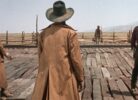To celebrate the upcoming release of my book, Akira Kurosawa: A Viewer’s Guide, due out Dec. 15 from Rowman & Littlefield — preorder here! — I’ll be doing capsule reviews all month covering every single Kurosawa film and posting (very) brief excerpts. These will be short impressions and recommendations, nothing more. For a full, detailed analysis of each, grab the book!
The Quiet Duel (1949)
Toshiro Mifune as a doctor stricken with a sexually-transmitted disease? Sure, why not!
Kurosawa’s 1949 drama about a doctor dealing with a terrible secret doesn’t get much attention. It might be easy to blame the studio (this was the director’s first work outside the Toho system) or the lack of a strong home release version (there is no Criterion edition to appeal to cinephiles), but the truth is that if there is blame, it’s with the film itself. In a career filled with dynamic, powerful films, The Quiet Duel is, well … quiet.
That’s not to say it’s without merit. Mifune’s acting is strong, providing a more subtle showcase of his abilities. The themes are potent and fit well with the exploration of postwar Japan that dominated much of this period in Kurosawa’s career. Further, the director manages to add some interesting visual touches to a script that was initially intended for the stage.
However, from the book:
He’d tackle the themes dealt with here better in other films (mortality in Ikiru, troubled relationships in One Wonderful Sunday, personal and social responsibility in The Bad Sleep Well, etc.). The legendary Toshiro Mifune would offer more compelling performances in just about every other film he did with the director. Even the direction often borders on pedestrian, an example of Kurosawa’s neorealistic influences of the period rather than the more dynamic work for which he is best known.
Fans of Mifune will want to see this in order to appreciate just how nuanced his acting could be when not playing a tough guy, but for casual fans, The Quiet Duel is not going to rank high on the “must see” list, especially not when straddled by two other masterful works, Drunken Angel and Stray Dog.
Check out my upcoming book for a full analysis exploring this film’s ideas, themes, good points, and bad
You can get the movie in this DVD edition.







